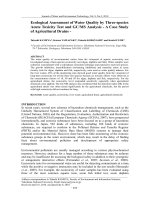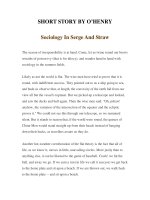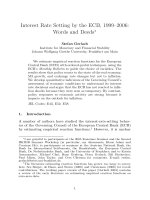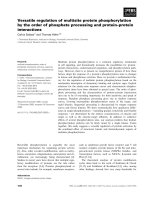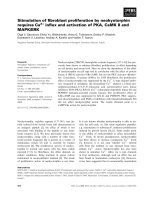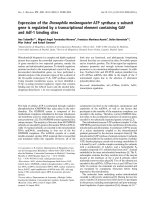Correct spatially varying image blur by projective motion richardson lucy algorithm and blur image alignment
Bạn đang xem bản rút gọn của tài liệu. Xem và tải ngay bản đầy đủ của tài liệu tại đây (12.5 MB, 72 trang )
CORRECT SPATIALLY VARYING IMAGE BLUR BY
PROJECTIVE MOTION RICHARDSON-LUCY ALGORITHM
AND
BLURRED IMAGE ALIGNMENT
Gao Long
NATIONAL UNIVERSITY OF SINGAPORE
2010
CORRECT SPATIALLY VARYING IMAGE BLUR BY
PROJECTIVE MOTION RICHARDSON-LUCY ALGORITHM
AND
BLURRED IMAGE ALIGNMENT
Gao Long
(B.Eng.(Hons.), NUS)
A THESIS SUBMITTED
FOR THE DEGREE OF MASTER OF ENGINEERING
DEPARTMENT OF ELECTRICAL & COMPUTER ENGINEERING
NATIONAL UNIVERSITY OF SINGAPORE
2010
PROJECTIVE MOTION RICHARDSON-LUCY ALGORITHM &
BLURRED IMAGE ALIGNMENT
GAO LONG
2010
Acknowledgments
My sincere appreciation goes to my supervisor Assistant Professor Tan Ping. Not only
has he guided me along the projects, his inspiration and devotion has been my constant
source of motivation.
My heartfelt gratitude also goes to my sponsor and supervisor Associate Professor
Ashraf Kassim, for his encouragements and support.
I would like to thank Mr. Tai Yu-Wing, who was Prof. Brown’s PhD student,
currently an Assistant Professor at Korean Advanced Institute of Science and
Technology (KAIST), and who I worked closely with on the project.
I am also thankful to Associate Prof. Michael Brown from School of Computing, NUS,
who enlightened me on new ways of tackling problems.
i
PROJECTIVE MOTION RICHARDSON-LUCY ALGORITHM &
BLURRED IMAGE ALIGNMENT
GAO LONG
2010
Content
ACKNOWLEDGMENTS ..................................................................................................................... I
SUMMARY ............................................................................................................................................V
LIST OF FIGURES........................................................................................................................... VII
LIST OF TABLES ........................................................................................................................... VIII
CHAPTER 1.
INTRODUCTION .................................................................................................. 1
1.1.
Modeling and Correcting Spatially Varying Motion Blur................................................................1
1.2.
Blurred Image Alignment ..............................................................................................................4
1.3.
Organization of this Thesis ............................................................................................................6
CHAPTER 2.
LITERATURE REVIEW ...................................................................................... 7
2.1.
Image Coordinates ........................................................................................................................7
2.2.
Planar Transformations.................................................................................................................7
2.3.
Traditional Pixel-based Image Alignment (Registration) ...............................................................9
2.4.
Non-Blurred /Blurred Image Pair Alignment. ..............................................................................11
2.5.
Richardson-Lucy Deconvolution ..................................................................................................12
2.6.
Regulations .................................................................................................................................15
ii
PROJECTIVE MOTION RICHARDSON-LUCY ALGORITHM &
BLURRED IMAGE ALIGNMENT
GAO LONG
2010
2.7.
Deblurring Blurred/Noisy Image Pair ..........................................................................................18
2.8.
Deblurring Blurred/Blurred Images .............................................................................................19
2.9.
Hybrid Camera ............................................................................................................................20
CHAPTER 3.
PROJECTIVE MOTION RICHARDSON-LUCY (RL) ALGORITHM..... 21
3.1.
Projective Motion Blur Model .....................................................................................................21
3.2.
Projective Motion Richardson Lucy (RL) Algorithm .....................................................................24
3.3.
Adding Regularization .................................................................................................................27
3.4.
Motion Estimation ......................................................................................................................28
CHAPTER 4.
EXPERIMENT RESULTS AND DISCUSSION ............................................ 31
4.1.
Convergence Analysis .................................................................................................................31
4.2.
Qualitative Analysis ....................................................................................................................32
4.3.
Run Time Analysis .......................................................................................................................36
4.4.
Limitations ..................................................................................................................................36
4.5.
Further directions .......................................................................................................................37
CHAPTER 5.
BLURRED IMAGE ALIGNMENT .................................................................. 38
5.1.
Background .................................................................................................................................38
5.2.
Blurred image Alignment - Theory ..............................................................................................39
iii
PROJECTIVE MOTION RICHARDSON-LUCY ALGORITHM &
BLURRED IMAGE ALIGNMENT
GAO LONG
2010
5.3.
Implementation and Acceleration...............................................................................................41
5.4.
Experiment and Result ................................................................................................................43
CHAPTER 6.
CONCLUSION ..................................................................................................... 48
REFERENCES.................................................................................................................................... 50
PUBLICATIONS ............................................................................................................................... 55
APPENDIX A: EXPERIMENTS ON BLURRED IMAGE ALIGNMENT .............................. 56
APPENDIX B: TEST RESULTS - PROJECTIVE MOTION RL ............................................. 57
iv
PROJECTIVE MOTION RICHARDSON-LUCY ALGORITHM &
BLURRED IMAGE ALIGNMENT
GAO LONG
2010
Summary
Blur is a typical image artifact when pictures are taken with long exposure or with
moving objects. A lot of research has been carried out on the topic of image
deblurring. Many methods assume each pixel in the image undergoes the same
amount of blur. However, the relative motion between a camera and the scene often
causes spatially varying blur which is different at every pixel. Although it is observed
that most of the image blurs are spatially variant in recent works (1), there is no
existing model to represent or to reduce spatially varying blurs.
This thesis addresses the problem of modeling and correcting spatially varying image
blurs caused by rigid camera motion. It first presents a new Projective Motion Blur
Model which models a blurred image as an integration of a sequence of projectively
transformed clear images. These projective transformations describe the camera’s
motion during exposure. This formulation is derived according to the physical cause
of the blurring effect and also offers a compact representation of the spatially varying
blur. Subsequently, we propose the Projective Motion Richardson-Lucy (RL)
algorithm to recover a clear image from an image undergoing spatially varying blur.
We also incorporated state-of-the-art regularization image priors to improve
deblurring results.
We further investigated the deblurring problem when multiple blurred images of the
same scene are available. To make use of complementary information in different
v
PROJECTIVE MOTION RICHARDSON-LUCY ALGORITHM &
BLURRED IMAGE ALIGNMENT
GAO LONG
2010
images, these blurred images must be registered to each other. However, existing
image registration algorithms only apply on clear images. Hence, we propose a
method to align blurred images. The algorithm in this thesis uses frequency domain
properties of the blurred images for alignment, which is both efficient and effective.
The key feature of this method is that it could align motion blurred images.
vi
PROJECTIVE MOTION RICHARDSON-LUCY ALGORITHM &
BLURRED IMAGE ALIGNMENT
GAO LONG
2010
List of Figures
Figure 2-1: Mapping from pixel coordinates to normalized coordinates ............................. 7
Figure 2-2 Planar transformations .......................................................................................... 8
Figure 2-3. Estimated kernel ................................................................................................. 12
Figure 2-4 Blur kernel
for pixel location x ...................................................................... 13
Figure 3-1 Result of Projective Motion RL algorithm ........................................................ 21
Figure 3-2 Demonstration of Projective Motion Blur ......................................................... 22
Figure 3-3 Compare of projective motion blur model and conventional model. .............. 23
Figure 3-4 Overview of Projective Motion RL algorithm. ................................................. 26
Figure 4-1 Convergence rates of Projective Motion RL algorithm .................................... 31
Figure 4-2. Image Deblurring on Hybrid Camera data set.................................................. 34
Figure 4-3 Example of Zooming blur................................................................................... 35
Figure 4-4 Example of Rotational blur................................................................................. 35
Figure 5-1. Example of Alignment on Synthetic Data ........................................................ 44
Figure 5-2. A Typical Search Routine for alignment .......................................................... 45
Figure 5-3. Alignment on real image pairs from (2) ........................................................... 46
vii
PROJECTIVE MOTION RICHARDSON-LUCY ALGORITHM &
BLURRED IMAGE ALIGNMENT
GAO LONG
2010
List of Tables
Table 4-1 Pixel RMS error in synthetic test......................................................................... 33
Table 5-1. Error on synthetic images with different noise level......................................... 46
viii
PROJECTIVE MOTION RICHARDSON-LUCY ALGORITHM &
BLURRED IMAGE ALIGNMENT
GAO LONG
2010
Chapter 1.
Introduction
1.1.
Modeling and Correcting Spatially Varying Motion Blur
Motion blur is an artifact in photography caused by relative motion between the
camera and an imaged scene during exposure. Ignoring the effects of defocusing and
lens distortion, each point in the scene is imaged into its point spread function (PSF),
sometimes also called the “blur kernel”, which describes the relative motion
trajectory at that pixel position. Image deblurring, to recover a clear image from a
blurry input, is a well studied problem and is known to be ill-posed that multiple
different clear images can produce the same blurred image by convolution with an
appropriate kernel. Nonetheless, this problem has received extensive study because of
its utility in photography. A common assumption in motion deblurring is that the
motion is spatially invariant so that each pixel, regardless of its position, shares the
same global PSF. This assumption implies that the motion blur effect is caused by the
camera’s translational motion.
Then the blurred image can be expressed as a
convolution between the clear image I and blur kernel K, plus noise n:
=I⊗K+n
( 1-1)
The goal of image deblurring is to reconstruct the clear image I from a degraded
image B. If both kernel and true image are unknown, the deblurring is called blind
1
PROJECTIVE MOTION RICHARDSON-LUCY ALGORITHM &
BLURRED IMAGE ALIGNMENT
GAO LONG
2010
deconvolution; if only the true image is unknown and blur kernel is known, the
deblurring technique is called non-blind deconvolution. Well known non-blind
deblurring algorithms include Richardson-Lucy (RL) algorithm (2) (3) and Wiener
filter (4). While these algorithms can produce deblurred results, they often suffer from
artifacts such as ringing due to frequency loss and poor PSF estimation. Recent works
focus on how to improve deblurring results by imposing various image priors to
better estimate of the PSF and to suppress ringing artifacts. Fergus et al (5) proposed
a blind deconvolution technique by using natural image statistics to estimate a more
accurate PSF. Several regularization terms were used to reduce artifacts during
deblurring process, Dey et al (6) introduced total variation regularization in the RL
algorithm, Levin et al (7) introduced the gradient sparsity prior and Yuan et al (8)
proposed bilateral regularization on progressive multi-scale approach. Shan et al (9)
introduced regularization based on high order partial derivatives to constrain image
noise. An evaluation on the state-of-the art deblurring algorithms was presented in
Levin et al. (1). Other recent methods improved deblurring results relying on multiple
images or special hardware setups. For example,
Yuan et al (10) used noisy and
blurred images pair, Rav-Acha and Peleg (11) and Chen et al (12) used blurred
images pair. Raskar et al (13), (14) coded the exposure to make the PSF more
suitable for deconvolution. Ben-Ezra and Nayar (15) (16) proposed a hybrid camera
to capture a high resolution blurred image together with a low resolution video which
was used to provide an accurate estimate of PSF.
All these works assumed the blur is spatially invariant. However, in many cases, the
PSF varies spatially over the degraded image. Early work by Sawchuk (17) addressed
2
PROJECTIVE MOTION RICHARDSON-LUCY ALGORITHM &
BLURRED IMAGE ALIGNMENT
GAO LONG
2010
spatially varying motion blur by image coordinate transformations, e.g. log-polar
transformation, which transformed rotational motion into a spatially invariant
representation and then solved it by conventional spatially invariant deconvolution
algorithms. Another strategy was to segment the blurred image into multiple regions,
each with a constant PSF (7) (18) (19) (20). However, this is difficult even in simple
cases of rotation or zooming of the camera. Shan et al (21) handled spatially varying
blur by restricting the relative motion to global rotation. Joshi et al (22) estimated a
PSF at each pixel for images with defocus blur. Special hardware setups were also
used to handle spatially varying blur. Tai et al (23) (25) extended the hybrid camera
framework in (15) (16) to estimate a PSF at each pixel using optical flow.
On the other hand, as recently discussed by Levin et al (1), the global PSF assumption
for blurred images caused by camera motion is inaccurate for practical purposes. In
their experiments, images taken by a handhold camera with motion blur exhibited
notable amounts of camera rotation which causes the motion blur to be spatially
varying within the image. As a result, Levin et al (1) advocated the need for better
motion blur models as well as image priors to improve the deblurred results.
In view of the need of dealing with spatially varying blur, we propose a new model
which is able to describe spatially varying blur caused by camera motion during
exposure. The new blur model is referred to as “Projective Motion Blur Model”. It
represents the degraded image as an integration of the clear scene under a sequence of
projective motions. The benefits of this model are that 1) it describes the spatially
varying blur on the whole image and 2) it does not require storing a different PSF at
every pixel to describe the blur. During deblurring, it is not necessary to segment the
3
PROJECTIVE MOTION RICHARDSON-LUCY ALGORITHM &
BLURRED IMAGE ALIGNMENT
GAO LONG
2010
image into regions of locally invariant blur as in several previous works. However
this blur model also has a drawback. Because this approach is not based on
convolution with a PSF, it is very hard to be analyzed in the frequency domain.
Another contribution of this project is a non-blind deblurring algorithm according to
the proposed blur model. We extended the Richardson-Lucy (RL) algorithm to
correct spatially varying motion blur under this novel “Projective Motion Blur
Model”. The modified RL algorithm is referred to as “Projective Motion RichardsonLucy algorithm”. To reduce the ringing artifacts in the result, regularizations derived
from image priors can be incorporated, as in the conventional RL algorithm.
In summary, this thesis focuses on developing the projective motion blur model and
the non-blind deblurring algorithm. The assumptions are: 1) the motion of the camera
is known; 2) the scene is distance and static, so that the camera motion satisfies our
Projective Motion Blur Model. Potential methods for accurately estimating the
projective motion are briefly discussed as well.
1.2.
Blurred Image Alignment
Multiple blurred images of the same scene provide complementary information for
deblurring, e.g. two blurred images were used to estimate a clear image in (12), and
blurred/noisy image pair in (10). To overcome the difficulty of spatially varying blur,
we propose to use multiple images as well. But this requires an alignment
(registration) among these images in preprocessing stage. Image alignment is a
4
PROJECTIVE MOTION RICHARDSON-LUCY ALGORITHM &
BLURRED IMAGE ALIGNMENT
GAO LONG
2010
fundamental task that is used widely in many multi-image applications, such as image
stabilization, image enhancement, panorama, satellite photo stitching and many other
graphical applications. Traditional image alignment techniques include pixel-based
method and feature-based method. A comprehensive review of image alignment can
be found in (25). However traditional image alignment methods only work with clear
images. Applying them to blurred images will lead to incorrect alignment especially
when the blur is significant.
The alignment on blurred images is non-trivial. One approach is to first deblur the
image. Rav-Acha et al (26) (11) proposed that by limiting the blur kernel to be one
dimension, alignment and deblurring can be solved simultaneously. Flusser and Suk
(27) proposed a moment-based invariant to align blurred images with a centrally
symmetric blur kernel. However, centrally symmetric kernel is more likely to happen
in out-of-focus blur and is very rare in motion blur. So far there is no blur-invariant
feature for an arbitrary shape kernel. To align arbitrary motion blurred image, Yuan et
al (28) introduced a method to align Blurred/Non-Blurred image pair using the
kernel’s sparseness prior. Yuan et al (28) also observed the need for new method to
align two blurred images.
A simple and effective method is presented in this thesis to align two blurred images.
Neither deblurring the images nor estimating the blur kernel, our method makes use
of the fact that there are three color channels in one color image and all channels must
have the same blur kernel. Using this property, this project shows the alignment of
two blurred images can be solved by aligning two unknown kernels in Fourier
Domain. The blur kernel is assumed to be spatially invariant, and this method can
5
PROJECTIVE MOTION RICHARDSON-LUCY ALGORITHM &
BLURRED IMAGE ALIGNMENT
GAO LONG
2010
align two blurred images up to any affine transformation in principal. In this thesis,
only alignment under similarity transformation is tested, due to limitation of the
computational power,
1.3.
Organization of this Thesis
This thesis is organized in the following manner: Chapter 2 is a literature review on
the research topics on image alignment and deblurring, Chapter 3 describes the
Projective Motion Blur Model and Projective Motion RL algorithm with
implementation details. Chapter 4 provides an analysis on deblurring result, including
the convergence properties of proposed algorithm and its sensitivity to noise.
Projective Motion RL algorithm’s limitation and further research directions are also
discussed in Chapter 4. Chapter 5 presents the Blurred image alignment algorithm
with analysis on its accuracy. This thesis concludes in Chapter 6.
6
PROJECTIVE MOTION RICHARDSON-LUCY ALGORITHM &
BLURRED IMAGE ALIGNMENT
GAO LONG
2010
Chapter 2.
Literature review
2.1.
Image Coordinates
To facilitate working on images with different resolutions, it is better to normalize the
coordinates to [-1, 1] along x axis and [-a, a] along y axis, where ‘a’ is the aspect ratio.
As shown in Figure 2-1, an image with size W × H and pixel coordinates
is mapped to normalized coordinates = ( , ), or
= ( ̅, )
= ( , , 1) in homogeneous
coordinates. Throughout this thesis, normalized homogeneous coordinates is used
when referring to pixel coordinates.
Figure 2-1: Mapping from pixel coordinates to normalized coordinates
2.2.
Planar Transformations
Various 2D planar transformations are shown in Figure 2-2 (29).
7
PROJECTIVE MOTION RICHARDSON-LUCY ALGORITHM &
BLURRED IMAGE ALIGNMENT
GAO LONG
2010
Figure 2-2 Planar transformations
=
Translation: 2D translations can be written as
=
+ or
1
( 2-1)
where I is the 2×2 identity matrix. and = ( , )′
Rotation + translation: This is also known as Euclidean transformation, since
Euclidean distance is preserved. It can be written as
where
is an orthonormal rotation matrix with
=
=
1
cos
sin
( 2-2)
− sin
cos
= and | | = 1
Rotation + translation + scaling: Also known as the similarity transform, it
preserves angles between lines which can be written as
=
where
is an arbitrary scaling factor.
=
1
0
−
0
1
( 2-3)
Affine Transformation: Parallel lines remain parallel under affine transformations.
=
0
0
1
( 2-4)
8
PROJECTIVE MOTION RICHARDSON-LUCY ALGORITHM &
BLURRED IMAGE ALIGNMENT
GAO LONG
2010
Projective Transformation: This is also known as perspective transformation or
homography.
=
2.3.
( 2-5)
Traditional Pixel-based Image Alignment (Registration)
Traditional Image alignment can usually be categorized into pixel-based and featurebased alignments. Feature-based registration is more robust in general. However,
when dealing with blurred image, most feature-based methods will fail as it is often
hard to extract features or to keep the features invariant under blur, e.g. Harris corners
and SIFT are not blur invariant according to a recent work by Yuan el al (28) “so far
there is no blur-invariant feature for an arbitrary shape kernel”. Therefore this section
will only talk about pixel-based alignment.
Error metrics is the simplest way to align two images with relative translational
motion. Given a template image I0(x) sampled with discrete pixel locations { x i =
(xi ,yi ) } , the solution is to find the minimum of the cost function
( )=
where
functions.
is called residual error.
(
+ )− ( ) =
( )
( 2-6)
(∙) can be absolute, square or other robust
Normalized cross-correlation is to find the maximized product of the two aligned
image
9
PROJECTIVE MOTION RICHARDSON-LUCY ALGORITHM &
BLURRED IMAGE ALIGNMENT
( )=
where
=
∑
∑| (
GAO LONG
+ )− |∙| ( )−
∑| (
|=
+ )− | ∙| ( )− |
2010
( 2-7)
( ) is the mean of the image. This method is invalid when either
image has zero variance, as in that case denominator becomes zero. In fact,
performance degrades in the case of low-contrast and noisy images.
Fourier Domain
If two images are related by a translation = ( ,
+
, +
=
), which can be represented by
( , ). In Fourier Domain, it becomes
(
( , )=
)
( , )
(
)
The cross-power spectrum is defined as
( , )=
|
∗
∗|
=
( 2-8)
( 2-9)
where * denotes complex conjugate. The translation can be found by applying inverse
Fourier transform.
( ,
)=
max
This technique is called phase correlation (29).
,
( ( , ))
( 2-10)
If the two images also cantain rotations and scalings, it also can be solved in log-polar
representations (30).
In case of rotation,
( , )=
( cos ′ + sin ′ −
Fourier Domain it becomes
( , )=
By taking the magnitudes of
0
, cos ′ − sin ′ −
( cos ′ + sin ′ , cos ′ − sin ′)
and
1,
). In
( 2-11)
10
PROJECTIVE MOTION RICHARDSON-LUCY ALGORITHM &
BLURRED IMAGE ALIGNMENT
( , )=
GAO LONG
( cos ′ + sin ′ , cos ′ − sin ′)
2010
( 2-12)
The magnitudes of the two spectra differ by a rotation. It can be converted to the
translational case by using polar representation
( , )=
In a similar way, the scaling case
domain as
( , − ′)
( , )=
( , )=
|
1
|
(
,
( 2-13)
) transforms into Fourier
( , )
( 2-14)
which can be converted to translation movement using log representation, ignoring
the multiplication factor 1/
where
= log( ) ,
( ′, ′) =
= log( ) ,
(
−
= log( ) and
,
− ′)
( 2-15)
= log( ).
Combining the translation, rotation and scaling (by single factor, i.e.a = ) , the
Fourier translation can be related by power magnitude in log-polar representation as:
where
= log( ) and
( ′, ) =
(
− ′, − ′)
= log( ). After removing rotation
( 2-16)
and scaling factor
in the images, translation can be recovered by phase correlation easily.
The advantage of Fourier domain alignment is that it is more computationally
efficient than that in pixel domain, especially after rotation and scaling transformation,
but the two images have to be largely overlapped to make this algorithm work.
2.4.
Non-Blurred /Blurred Image Pair Alignment.
11
PROJECTIVE MOTION RICHARDSON-LUCY ALGORITHM &
BLURRED IMAGE ALIGNMENT
GAO LONG
2010
As traditional alignment only works on clear images, Yuan et al (28) proposed this
method to align a Clear/Blurred image pair, under the assumption that the image blur
is caused by camera motion instead of out of focus blur. The main idea was to use the
kernel’s sparseness prior to solve the alignment. Because clear image and blurred
image
were known, the blur kernel
=
can be solved by
min‖ − ⊗ ‖ + ‖ ‖
subject to
≥ 0 and
=1
( 2-17)
If the blur is caused by camera motion and the alignment is correct, the kernel
should be sparse, as shown in Figure 2-3 (a). On the other hand, if alignment is
incorrect, e.g. with an error of 0.7 degree, then estimated kernel by Equation ( 2-17)
could be much more noisy, as shown in Figure 2-3 (b). It was also claimed that the
true alignment produces the most sparse kernel (28). The alignment can then be
solved by a coarse-to-fine brute force search. In (28), the alignment problem was
resolved under affine transform by 4D search.
(a)
(b)
Figure 2-3. Estimated kernel
(a) by correct alignment, (b) with alignment error of 0.7° in rotation
2.5.
Richardson-Lucy Deconvolution
According to (2) (3), given the motion blurred image B and blur kernel K, the clear
image I can be computed by Bayesian estimation. As all image intensities can be
12
PROJECTIVE MOTION RICHARDSON-LUCY ALGORITHM &
BLURRED IMAGE ALIGNMENT
GAO LONG
2010
normalized to range between 0 and 1, and the kernel entries sum to 1 (Figure 2-4).
The pixel intensities can be treated as probabilities. As a result the blurred image
= ⊗
can be represented as
(
where
(
) = ( ),
)=
= ( ) and
position in the blur kernel centered at
Figure 2-4 Blur kernel
( 2-18 )
( )
=
( , ) is the value at
position as shown in Figure 2-4
for pixel location x, ∑
( , )=1
Therefore the pixel value of the clear image ( ) can be computed according to
pixel values of the blurred image (
) by the following formula.
( )=
By Bayes’ rule,
(
( 2-19 )
)
can be computed and ( ) can be written as:
( )=
Both sides of this equation contain
∑
( )
( )
(
)
( 2-20 )
( ), which complicates the computation. To
break the dependency, a general and acceptable practice is to make the best out of a
13
PROJECTIVE MOTION RICHARDSON-LUCY ALGORITHM &
BLURRED IMAGE ALIGNMENT
GAO LONG
2010
bad situation and to use a current estimation of ( ) to approximate
.
Hence an iterative algorithm is used as:
( )=
=
( )
( )
∑
( )
∑
( )
=
( 2-21 )
( )
where is an iteration index. Under the conventional blur model that
∑
= ( , ) is the PSF at location y and ∑
( )=
estimated clear image
⊗
.
= ⊗
( , )=1 ,
,
=
is the prediction of the blurred image according to
=
is the residual error (pixel-wise division) between
the real blurred image and the predicted blurred image. ∑
is the
amendment term according to the residual, which can be computed by
∗
. Here
⊗ and ∗ are convolution and correlation operators respecively. Hence the previous
equation can be written as:
=
×
∗
⊗
( 2-22 )
The Richardson-Lucy algorithm essentially minimizes the difference between the
original blurred image
and the predicted blurred image
according to the
Poisson noise model:
where ( , ) =
/ !,
arg min ( , )
= ′and
=
( 2-23 )
is the probability distribution function
(pdf). Image noise is further assumed to be independent and identically distributed
14
PROJECTIVE MOTION RICHARDSON-LUCY ALGORITHM &
BLURRED IMAGE ALIGNMENT
GAO LONG
(i.i.d.). In (3), Lucy showed that based on Poisson noise distribution,
converged to 1 and hence
=
2010
∗
⊗
as → ∞, which is taken as a proof that the
Richardson-Lucy algorithm converges.
Other noise models, such as Gaussian model, also can be used. In this project, the
approach used in (23) (31) is used to assume Gaussian noise model, taking log on
both side of equation ( 2-22 ) and re-define the variables to obtain
=
+
∗( −
⊗ )
( 2-24 )
The convergence of equation ( 2-24 ) was proved in (31).
2.6.
Regulations
The result derived in the previous section is a maximum likelihood with respect to
Poisson or Gaussian noise models and imposes no regularization on the solution. The
main problem is artifacts such as ringing. Recent deblurring works (6), (32), (8)
have shown that imposing certain images priors can significantly reduce the ringing
artifact.
Total variation
The total variation (TV) regularization was introduced by Dey et al (6). The purpose
of this regularization is to suppress image noise amplified during the deconvolution
process by minimizing the magnitude of gradients in deblurred image:
15
